
Now, Part II of Livefist’s special series by COLONEL (RETD) VINAYAK BHAT (@RajFortySeven), a veteran military satellite imagery specialist. Today’s is the first detailed look at China’s secretive hypersonic wind tunnel test facilities.
USA and Russia have been testing hypersonic glide vehicles (HGV) for a long time now. In the last three years China too has jumped into the race, creating quite a few global ripples. Not much is fully known about the Chinese glider — codenamed Wu-14 by the Pentagon probably based on its launch being from Wuzhai. The Chinese internet has dubbed it DF-ZF (的ZF可能指的是“再飞”=再入飞行器, Z for re-entry, F for flying vehicle). Reasons for the origins of both names remain unclear, like much of the programme.
Recently, there has been a spurt of news regarding the Chinese HGV especially in the U.S. and in the media of its allies Japan and South Korea. The Taiwan print media has also reported on it. The Indian media, interestingly, has shown no signs of alarm or interest — and has in fact been surprisingly quiet on this issue. It is not clear what India’s official assessment of the Chinese developments is. US experts are unwilling to accept that China really possesses the capability or can deploy HGVs in any near time frame. Recent testimony by James M. Acton of the Carnegie Endowment before the US-China Economic and Security Review Commission also claims that “[G]iven sufficient time and resources, China should be able to overcome these challenge, just as the United States seems to have done, as well as the other obstacles it would face. This process is, however, unlikely to be quick or painless.” Physicists like Mark Gubrud even go one step further to say “Most “reporting” on (Chinese) emerging military technology can be characterized as a rumo(u)r mill.”
I made a quick attempt to brush aside traditional Chinese clouds of military secrecy that shroud this high-tech project and identify any signatures of Chinese HGV testing through open source Google Earth satellite imagery. And there it was, in the full view for everyone to see: what appears to be solid and substantial proof of China’s supersonic and hypersonic wind tunnel testing.
The Tests Conducted
Since the first HGV test conducted by China on January 09, 2014 six more tests have been conducted and all except the second test have been considered successful.
| Date | Range (km)
|
Notes |
| January 9, 2014
|
1,750 | Only one keep-out zone declared. That zone was, however, identical to one of the zones for August 2014 test, strongly suggesting an identical flight path. |
| August 7, 2014 | 1,750 | Probable failure. |
| December 2, 2014
|
1,750? | Flight path closures but not keep-out zones declared. Flight path possibly similar to the previous two tests. |
| June 7, 2015 | 1,750 | Flight path similar but not identical to August 2014 test. |
| August 20, 2015. | 2,100 | Terminal manoeuvring possibly planned |
| November 23, 2015 | 1,250 | |
| April 22, 2016 | 1,250 | Flight path identical to November 2015 test. |
Comparing Chinese HGV with US Advanced Hypersonic Weapon (AHW) Programme
Very little has been published on the Chinese HGV programme by authentic Chinese sources. On the contrary, a lot has been written about US AHW programme. The Chinese HGV programme has rapidly progressed as other major arms programmes by copying the basic technology and later adding own innovations. Hence, would be much cheaper too. Thus drawing comparisons is much difficult. The main points that can be compared are:-
- Time Lag. The US hypersonic programme is old and China has just started. China’s HGV achievements are almost matching the US achievements in such a short span of time. This although commendable, creates doubts about its efficacy of the HGV at the target end.
- Propellant Used. The US AHW is based on a three stage booster on solid propellant whereas Chinese HGV is based on two stages with at least one stage on liquid propellant.
- The US AHW is being tested at more than 20 Mach and Chinese is supposedly between 10-20 Mach. The speed considerations are based on assumptions that China needs facility to test the HGV in a wind tunnel especially at supersonic/hypersonic speeds.
- Wind Tunnel Testing. The US has a large number of facilities for wind tunnel testing of its AHW. On the other hand, it is opinionated that China may not yet have wind tunnel testing facility for the HGV (refer James Acton testimony).4 This report counters that China has recently built a large wind tunnel test facility.
Wind Tunnel Test Facility
Overview. A large Chinese wind tunnel facility has been located for the first time. This large facility of 660 acres located 6 km West of the Mianyang airport, Sichuan has three closed loop wind tunnels, two facilities for scramjet vacuum spheres and what appears to be a hypersonic impulse tunnel. The solid walled facility also has administrative buildings, auxiliary buildings and a large parking space. This facility is claimed to be largest wind tunnel testing facility in the world by some experts.
Closed Circuit Wind Tunnels. There are three closed circuit (also known as closed return) wind tunnels in this facility. All the three are of different sizes and shapes. This suggests that shape and size of articles tested obviously has to be different. Thus it debunks the estimation that all HGV tests were conducted with the same HGV. These wind tunnels are also used for propulsion and icing tests.
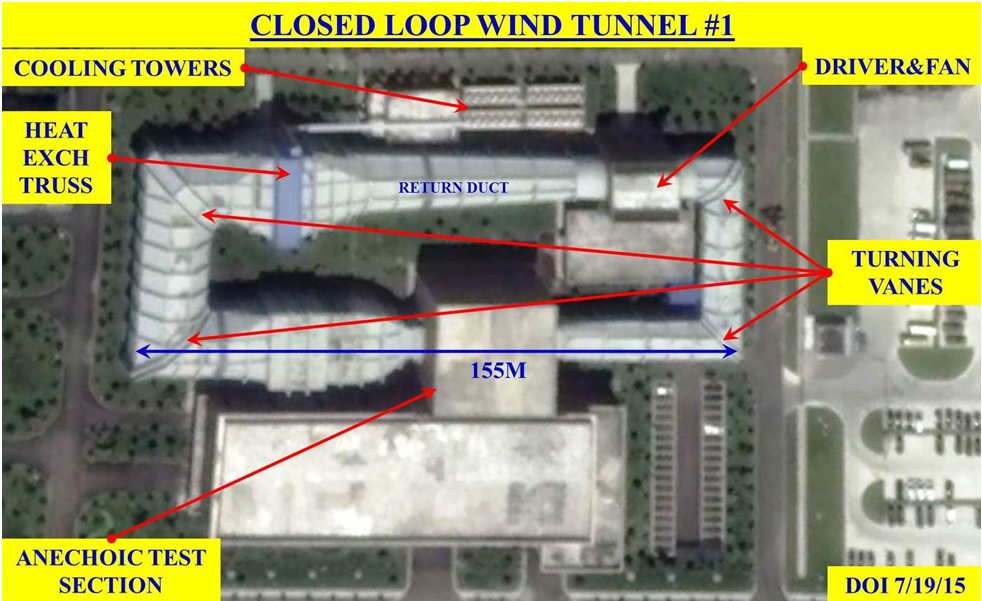

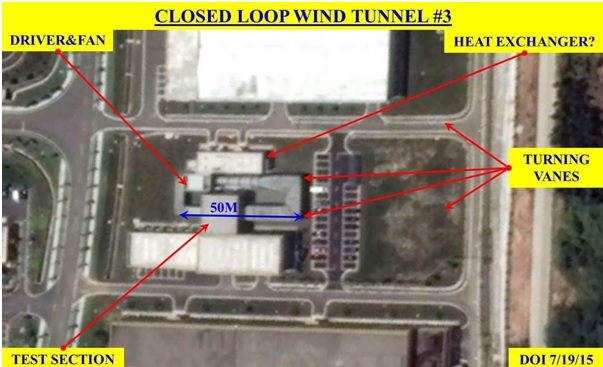
Scramjets Testing Facilities. There are four typical scramjet testing buildings with high pressure storage and vacuum spheres. These probably use arc-jet heaters with LN2 gas. The test sections with large entrances suggest that full scale models are also being tested at these facilities.
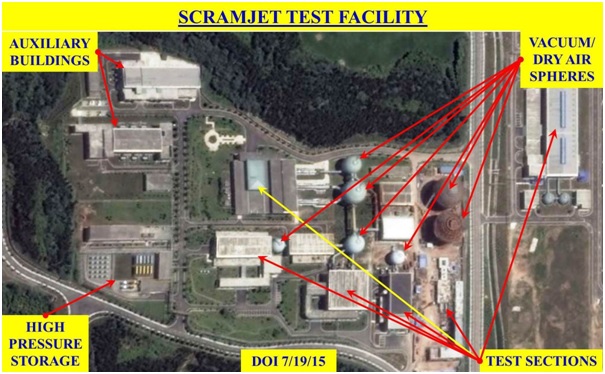
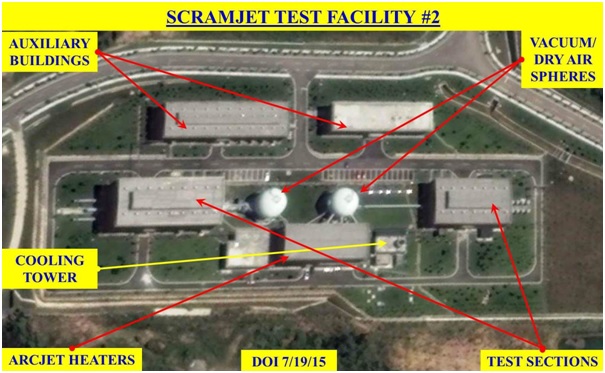
A new facility is under construction with at least ten vacuum spheres.
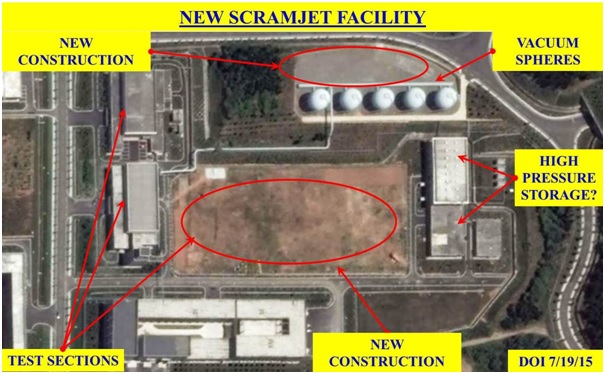
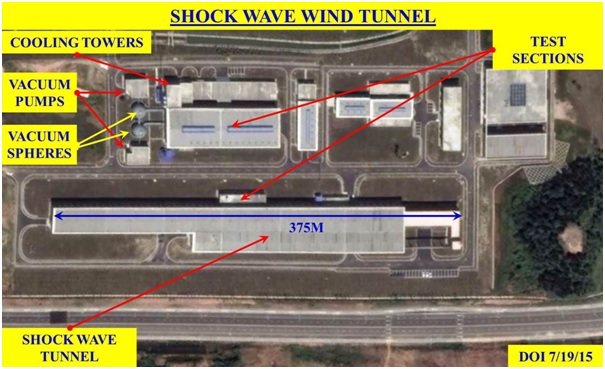
Auxilliary Buildings’ Complex. There are ten buildings in this complex. Some of them may be manufacturing the required models for the wind tunnel testing.

Administrative Complex. The administrative complex comprises of main administrative building with ten office buildings, a motor transport complex and a guest house. Surprisingly it also has a large 50m X 30m underground complex possibly a CBRN underground shelter in case of emergencies.

There is one large parking area in this complex.

Power Grid. The entire facility is supported by a very modern power grid. These grids are known to be accident proof with perfect electricity voltage and amperage supply.

Challenges
China seems to have overcome a large number of obstacles in the HGV project. But there still clearly remain a large number of challenges that China will face before deployment of any HGV as an effective weapon system. Experts believe China would face multiple challenges, certainly the following:
- Command and Control at Hypersonic Speeds. Communication systems are needed to control and manoeuvre the HGV at enormous speeds and great distances. It would likely remain a challenge for the Chinese scientists till they perform actual long distance tests of the HGV.
- The Beidou system of navigation although good still does not have a global reach. Until then efficacy of HGV will be questioned.
- The trajectory of HGV is much different from that of a ballistic missile. The ballistic missile path can be calculated till the re-entry vehicle (RV) separates, even by adversaries if detected in boost phase. On the other hand, in case of HGV the RV separates much earlier cruising at unpredictable path possibly along the atmosphere at the same time pulling evasive manoeuvres till the terminal re-entry. This science is extremely complex and very difficult to master.
- MIRV of HGV. It is still not known if China will try to MIRV its HGV or not. This would be a major area of constraint.
Implications
China’s accelerated achievements in HGV testing have raised doubts in many a minds as to the efficacy of its project. The evidence of China’s hypersonic wind tunnel testing facility amplifies vividly what has been achieved so far. The different sizes and types of hypersonic wind tunnel tests being carried out suggest that China’s HGV programme is maturing and capable of fielding different shapes and sizes of HGVs. The HGVs may carry a warhead of conventional, nuclear or something different altogether like an EMP generator (China has been testing EMP generators which will be covered in this author’s forthcoming article).
This evidence appears to somewhat blunt the U.S.’ temporal edge over China in hypersonic arena. It also appears to place the U.S. BMD programme at greater penetration risk. Additionally, it will be very difficult for any country to figure if the HGV is carrying a nuclear or a conventional warhead. This would bring in ambiguity and confusion in decision making at the highest levels. China’s ability to field a weapon with quick global reach is indeed a significant development. The HGV programme puts China in an elite club, sure, but some believe it also makes a casus belli against Beijing.
India, not to be left behind in this arena, has just commissioned its own hypersonic wind tunnel testing facility. This scenario is likely to start an open ended arms race in hypersonic field.
Recommendations
There is an urgent need for restraint on hypersonic testing. Perhaps treaty ban on testing, CBMs via talks and verification process should be put in place before it is too late. At the same time, it would be prudent for India to get Large Phased Array Radars (LPARs) with large ranges to detect and monitor Chinese hypersonic activities better. Development and fielding of phased array radars and a credible BMD thus becomes extremely important for India. India must boost its own research in this next arena of space race at the earliest.
References
1 China’s Advanced Weapons, James M. Acton, Testimony, February 23, 2017
2 Most “reporting” on emerging military technology can be characterized as a rumor mill, Mark Gubrud, February 27, 2017
3 China’s Advanced Weapons, James M. Acton, Testimony, February 23, 2017
4 Page 6, third para, China’s Advanced Weapons, James M. Acton, Testimony, February 23, 2017
5 The argument for a hypersonic missile testing ban, Mark Gubrud, September 02, 2014

Hypersonic is the next NPT. The big 5s would quickly scale up and once matured would roll out another CTBT to prevent other nations from developing it.
It is important for India to scale up, before the CTBT is put in place. I am thinking another 5 years, when the noise will be tremendous, specially once there is a news of Iranians try out their hand at hypersonic.
Good article
Common folks let’s work on ICBM defense and other prudent important things like get the instrument of war before it renters the atmosphere and destroy it or a worm and turn it back around and send it home to it’s takeoff point wouldn’t that be unerving for a would be aggressive nation to know that possibly your icbs would turn and bomb your own country. Hmmm
No faith in all BS info.